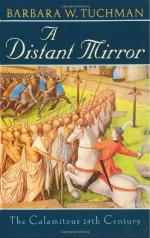
|
| Name: _________________________ | Period: ___________________ |
This test consists of 15 multiple choice questions and 5 short answer questions.
Multiple Choice Questions
1. What was the most applied science in the 14th century?
(a) Alchemy.
(b) Astrology.
(c) Bridge-building.
(d) Prophecy.
2. When did the Dauphin reinstate the chancellors and dismiss the Grand Council?
(a) 1351.
(b) 1357.
(c) 1361.
(d) 1355.
3. What was the result of the agreement between the Third Estate and Dauphin Charles?
(a) France would submit to England.
(b) The king would live more frugally.
(c) The king would abdicate and parliament would rule.
(d) Tax increases become solely the king's prerogative.
4. What happened to Coucy in 1197?
(a) It was developed into a castle.
(b) It was sold as a commune.
(c) It was attacked and ravaged.
(d) It was consolidated with neighboring territories.
5. What was the castle of Coucy primarily built for?
(a) A network of marketplaces.
(b) Foreign trade.
(c) Withstanding a siege.
(d) A center for art and literature.
6. When did Enguerrand become a historical figure?
(a) 1358.
(b) 1425.
(c) 1396.
(d) 1312.
7. Who was accused of poisoning wells?
(a) Knights Templar.
(b) Protestants.
(c) Gypsies.
(d) Jews.
8. What is the difference between the two types of plague?
(a) One could be survived.
(b) The length of time before death.
(c) One would affect the eyes.
(d) One would leave a person pockmarked.
9. Why did nobles neglect to condemn the luxuries of the clergy?
(a) Because the clergy still lived relatively Spartan existences.
(b) Because the nobility and clergy needed each other.
(c) Because the nobles profited from the clergy's decadence.
(d) Because the clergy was more powerful than the nobles.
10. What happened to the church during the plague years in the 14th century?
(a) It lost its authority because it could not stop the plague.
(b) It gained adherents as people sought explanations.
(c) It became more inclusive in order to maintain congregations.
(d) It gained authority as people died, and the church took their lands.
11. Which figures in the church offered believers solace?
(a) The pope.
(b) Patron saints.
(c) The bishops.
(d) The worshippers themselves.
12. Who led the Third Estate of Paris while Jean II was a captive of the English?
(a) Charles of Navarre.
(b) Etienne Marcel.
(c) Dauphin Charles.
(d) Philip Vi.
13. How did the church make money in the beginning of the 14th century?
(a) Selling offices and imposing fines.
(b) Selling slaves and imports.
(c) Taxing mercantile cities.
(d) Conquering foreign lands.
14. When did Philip the Fair accuse the Templars of heresy?
(a) 1307.
(b) 1523.
(c) 1352.
(d) 1136.
15. What was a knight's work in the 14th century?
(a) Nation-building.
(b) Fighting.
(c) Policing the cities.
(d) Politics.
Short Answer Questions
1. Where were Jews burned inside a house in a plague town?
2. Which parties were in political conflict in the beginning of the 14th century?
3. How are the wealthy different from the poor in size of their families?
4. When did Jean II face an English invasion?
5. When was the castle of Coucy built?
|
This section contains 450 words (approx. 2 pages at 300 words per page) |

|




